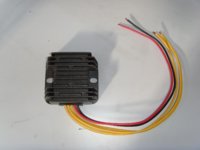Here is where I was getting some of my information from. And
here is where I first saw about them.
And here is the part that explains why they run cooler:
What is the difference between a thyristor and a MOSFET based R/R?
The switches in the Regulator part are either type, but they both do the same thing... The rapidly turn on and off, shortcircuiting power to ground to keep voltage constant... That's called "Shunting", and almost every type of bike R/R used now is made this way...
Every time you short circuit something, it creates heat, just from the short circuit... That's the same for both types... But, the difference is in how you switch!
On a thyristor based R/R the most heat isn't from the shortcircuit, it's from the switching... A thyristor is basically a diode with a separate leg, acting as a switch... But the switch has a delay... The thyristor relies on the current flowing through it, to keep it open...
Basically the switch opens the door a crack, and then waits for the current to crash into the door, slamming it open... Closing it is similar... You slowly, slowly push the door closed enough until the current looses power and cant hold the door open, slamming it shut...
As a result, the thyristor is horribly inexact and inefficient... It takes time to switch, and it creates huge amounts of heat while doing it...
The MOSFET is a bit more intelligent... It doesn't rely on the current for opening the door, and it doesn't try to close it slowly... Instead the switch is really a switch... Switching it on means it starts to conduct fast, and switching it off means it stops almost as fast... That creates a lot less heat, and makes it more exact... A lot more exact...

